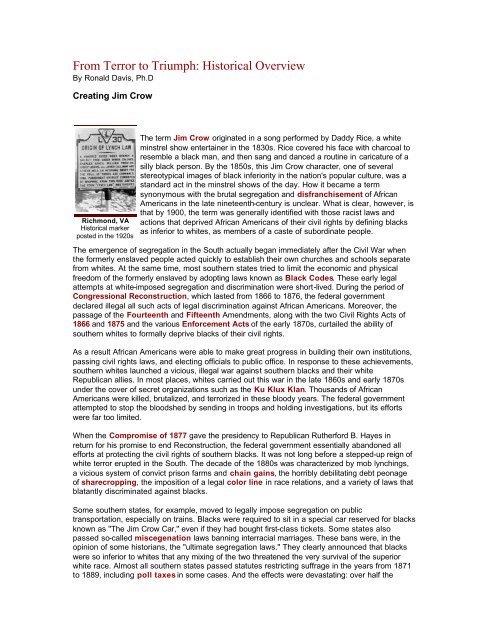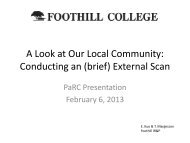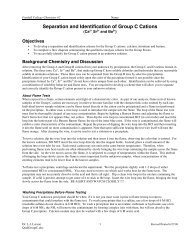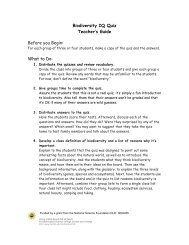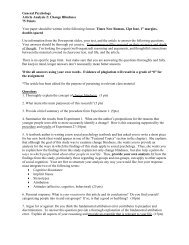From Terror to Triumph: Historical Overview - Foothill College
From Terror to Triumph: Historical Overview - Foothill College
From Terror to Triumph: Historical Overview - Foothill College
You also want an ePaper? Increase the reach of your titles
YUMPU automatically turns print PDFs into web optimized ePapers that Google loves.
<strong>From</strong> <strong>Terror</strong> <strong>to</strong> <strong>Triumph</strong>: His<strong>to</strong>rical <strong>Overview</strong><br />
By Ronald Davis, Ph.D<br />
Creating Jim Crow<br />
Richmond, VA<br />
His<strong>to</strong>rical marker<br />
posted in the 1920s<br />
The term Jim Crow originated in a song performed by Daddy Rice, a white<br />
minstrel show entertainer in the 1830s. Rice covered his face with charcoal <strong>to</strong><br />
resemble a black man, and then sang and danced a routine in caricature of a<br />
silly black person. By the 1850s, this Jim Crow character, one of several<br />
stereotypical images of black inferiority in the nation's popular culture, was a<br />
standard act in the minstrel shows of the day. How it became a term<br />
synonymous with the brutal segregation and disfranchisement of African<br />
Americans in the late nineteenth-century is unclear. What is clear, however, is<br />
that by 1900, the term was generally identified with those racist laws and<br />
actions that deprived African Americans of their civil rights by defining blacks<br />
as inferior <strong>to</strong> whites, as members of a caste of subordinate people.<br />
The emergence of segregation in the South actually began immediately after the Civil War when<br />
the formerly enslaved people acted quickly <strong>to</strong> establish their own churches and schools separate<br />
from whites. At the same time, most southern states tried <strong>to</strong> limit the economic and physical<br />
freedom of the formerly enslaved by adopting laws known as Black Codes. These early legal<br />
attempts at white-imposed segregation and discrimination were short-lived. During the period of<br />
Congressional Reconstruction, which lasted from 1866 <strong>to</strong> 1876, the federal government<br />
declared illegal all such acts of legal discrimination against African Americans. Moreover, the<br />
passage of the Fourteenth and Fifteenth Amendments, along with the two Civil Rights Acts of<br />
1866 and 1875 and the various Enforcement Acts of the early 1870s, curtailed the ability of<br />
southern whites <strong>to</strong> formally deprive blacks of their civil rights.<br />
As a result African Americans were able <strong>to</strong> make great progress in building their own institutions,<br />
passing civil rights laws, and electing officials <strong>to</strong> public office. In response <strong>to</strong> these achievements,<br />
southern whites launched a vicious, illegal war against southern blacks and their white<br />
Republican allies. In most places, whites carried out this war in the late 1860s and early 1870s<br />
under the cover of secret organizations such as the Ku Klux Klan. Thousands of African<br />
Americans were killed, brutalized, and terrorized in these bloody years. The federal government<br />
attempted <strong>to</strong> s<strong>to</strong>p the bloodshed by sending in troops and holding investigations, but its efforts<br />
were far <strong>to</strong>o limited.<br />
When the Compromise of 1877 gave the presidency <strong>to</strong> Republican Rutherford B. Hayes in<br />
return for his promise <strong>to</strong> end Reconstruction, the federal government essentially abandoned all<br />
efforts at protecting the civil rights of southern blacks. It was not long before a stepped-up reign of<br />
white terror erupted in the South. The decade of the 1880s was characterized by mob lynchings,<br />
a vicious system of convict prison farms and chain gains, the horribly debilitating debt peonage<br />
of sharecropping, the imposition of a legal color line in race relations, and a variety of laws that<br />
blatantly discriminated against blacks.<br />
Some southern states, for example, moved <strong>to</strong> legally impose segregation on public<br />
transportation, especially on trains. Blacks were required <strong>to</strong> sit in a special car reserved for blacks<br />
known as "The Jim Crow Car," even if they had bought first-class tickets. Some states also<br />
passed so-called miscegenation laws banning interracial marriages. These bans were, in the<br />
opinion of some his<strong>to</strong>rians, the "ultimate segregation laws." They clearly announced that blacks<br />
were so inferior <strong>to</strong> whites that any mixing of the two threatened the very survival of the superior<br />
white race. Almost all southern states passed statutes restricting suffrage in the years from 1871<br />
<strong>to</strong> 1889, including poll taxes in some cases. And the effects were devastating: over half the
lacks voting in Georgia and South Carolina in 1880, for example, had vanished from the polls in<br />
1888. Of those who did vote, many of their ballots were s<strong>to</strong>len, misdirected <strong>to</strong> opposing<br />
candidates, or simply not counted.<br />
In the 1890s, starting with Mississippi, most southern states began more systematically <strong>to</strong><br />
disfranchise black males by imposing voter registration restrictions, such as literacy tests, poll<br />
taxes, and the white primary. These new rules of the political game were used by white registrars<br />
<strong>to</strong> deny voting privileges <strong>to</strong> blacks at the registration place rather than at the ballot box, which had<br />
previously been done by means of fraud and force. By 1910, every state of the former<br />
Confederacy had adopted laws that segregated all aspects of life (especially schools and public<br />
places) wherein blacks and whites might socially mingle or come in<strong>to</strong> contact.<br />
The impetus for this new, legally-enforced caste order of southern life was indeed complex. Many<br />
lower-class whites, for example, hoped <strong>to</strong> wrest political power from merchants and large<br />
landowners who controlled the vote of their indebted black tenants by taking away black suffrage.<br />
Some whites also feared a new generation of so-called "uppity" blacks, men and women born<br />
after slavery who wanted their full rights as American citizens. At the same time there appeared<br />
throughout America the new pseudo-science of eugenics that reinforced the racist views of black<br />
inferiority. Finally, many southern whites feared that the federal government might intervene in<br />
southern politics if the violence and fraud continued. They believed that by legally ending suffrage<br />
for blacks, the violence would also end. Even some blacks supported this idea and were willing <strong>to</strong><br />
sacrifice their right <strong>to</strong> vote in return for an end <strong>to</strong> the terror.<br />
In the end, black resistance <strong>to</strong> segregation was difficult because the system of land tenancy,<br />
known as sharecropping, left most blacks economically dependent upon planter-landlords and<br />
merchant suppliers. Also, the white terror at the hands of lynch mobs threatened all members of<br />
the black family--adults and children alike. This reality made it nearly impossible for blacks <strong>to</strong><br />
stand up <strong>to</strong> Jim Crow because such actions might bring down the wrath of the white mob on<br />
one's parents, brothers, spouse, and children. Few black families, moreover, were economically<br />
well off enough <strong>to</strong> buck the local white power structure of banks, merchants, and landlords. To<br />
put it succinctly: impoverished and often illiterate southern blacks were in a weak position in the<br />
1890s for confronting the racist culture of Jim Crow.<br />
White terror did not end--as some blacks had hoped--with the disfranchisement of southern black<br />
men. To enforce the new legal order of segregation, southern whites often resorted <strong>to</strong> even more<br />
brutalizing acts of mob terror, including race riots and ritualized lynching, than had been practiced<br />
even by the old Klan of the 1870s. Some his<strong>to</strong>rians see this extremely brutal and near epidemic<br />
commitment <strong>to</strong> white supremacy as breaking with the South's more laissez-faire and paternalistic<br />
past. Others view this "new order" as a more rigid continuation of the "cult of whiteness" at work<br />
in the South since the end of the Civil War. Both perspectives agree, however, that the 1890s<br />
ushered in a more formerly racist South--one in which white supremacists used law and mob<br />
terror <strong>to</strong> deprive blacks of the vote and <strong>to</strong> define them in life and popular culture as an inferior<br />
people.<br />
Click here for an In-Depth Essay on Creating Jim Crow >><br />
Surviving Jim Crow
The Supreme Court's sanctioning of segregation (by upholding the "separate<br />
but equal" language in state laws) in the Plessy v. Ferguson case in 1896<br />
and the refusal of the federal government <strong>to</strong> enact anti-lynching laws meant<br />
that black Americans were left <strong>to</strong> their own devices for surviving Jim Crow. In<br />
most cases, southern blacks tried <strong>to</strong> avoid engaging whites as much as<br />
possible as the best means of avoiding their wrath. These efforts at avoiding<br />
whites meant supporting their own schools and community-based support<br />
groups as much as possible.<br />
W.E.B. Du Bois In the 1860s and early 1870s, many southern blacks actually preferred<br />
segregated schools, especially their all-black colleges, as a means of local<br />
au<strong>to</strong>nomy and independence--even though they had little choice in the matter after 1890. Many of<br />
these colleges became the primary centers of black resistance <strong>to</strong> Jim Crow, although their<br />
administra<strong>to</strong>rs and staff frequently differed over how best <strong>to</strong> make their stand. At the primary and<br />
secondary school levels, truly heroic efforts were made by impoverished black teachers <strong>to</strong><br />
educate their pupils, usually in face of white resistance that often included violence. Whites were<br />
generally so opposed <strong>to</strong> black education that many states in the South refused <strong>to</strong> build black<br />
public high schools until the twentieth-century. Despite the repression, the literacy rate of blacks<br />
nearly doubled from 1880 <strong>to</strong> 1930, rising from less than 45 percent <strong>to</strong> 77 percent--an incredible<br />
climb from the less than 7 percent who were literate in 1865.<br />
Additionally, southern blacks survived the demeaning character of Jim Crow by organizing selfhelp<br />
associations that functioned as parallel institutions <strong>to</strong> those in the white community, ranging<br />
from lodges and social clubs <strong>to</strong> life insurance programs and volunteer fire departments. By 1910,<br />
a wide range of segregated black institutions in southern communities served as refuges and safe<br />
harbors from white terror and violence; these social clubs and lodges enabled a small, middleclass<br />
of prosperous black participants <strong>to</strong> live in dignity and with self-respect.<br />
For the vast majority of southern blacks, the terror of Jim Crow meant that they were forced <strong>to</strong><br />
live" behind the veil," in the words of the black intellectual, W.E.B. Du Bois. In dealing with<br />
whites, most southern blacks were forced <strong>to</strong> adopt accommodationist and appeasement tactics<br />
that played out in complicated ways across the region. Scholars refer <strong>to</strong> these tactics as<br />
"dissembling," or a psychological ploy in which blacks assumed positions and the appearances of<br />
non-confrontation. Sometimes it meant shuffling and feigning irresponsibility, and sometimes it<br />
meant turning the other cheek and walking away. Almost always these appeasement stances<br />
meant adhering <strong>to</strong> a demeaning racial etiquette.<br />
Black cus<strong>to</strong>mers were almost never served first in s<strong>to</strong>res when white cus<strong>to</strong>mers were present,<br />
seldom allowed <strong>to</strong> try on clothing in white businesses, and typically forced <strong>to</strong> wait patiently <strong>to</strong> be<br />
spoken <strong>to</strong> by white s<strong>to</strong>re clerks rather than <strong>to</strong> dare address them directly. Nor were adult African<br />
Americans afforded terms of respect, such as "Mister," "Mrs.," or "Miss." Instead, they endured<br />
words such as "boy," "girl," "uncle," "auntie," and often "nigger."<br />
When among themselves, African Americans resisted these insults by mocking whites in song,<br />
jokes, and s<strong>to</strong>ries. They would even sing these songs of mockery as they worked when whites<br />
were present. This reflected a long his<strong>to</strong>ry of "putting on the man, " or playing Sambo, in order <strong>to</strong><br />
manipulate white masters and better control the otherwise powerless situation of their lives in<br />
slavery. Tragically, many southern whites came <strong>to</strong> expect this type of docile behavior from all<br />
blacks, demanding it during and after slavery under the threat of violence. This Sambo character<br />
(an innately barbaric, passive, cheerful, childish, lazy, and submissive black) was commonly<br />
accepted as reality in both the southern and northern states.<br />
Over time, this Sambo-type image was immortalized in literature and film of the period, usually in<br />
the character of Uncle Tom, Uncle Remus, Jim Crow and "Old Black Joe." D.W. Griffith's classic<br />
silent film "The Birth of a Nation," released in 1915, depicts elected black congressmen during<br />
Reconstruction as ape-like characters, eating bananas on the floor of Congress. This image was
further repeated in white-produced movies with black film ac<strong>to</strong>rs often cast as a lazy, submissive,<br />
and innately docile character who spoke in the same manner as did black slaves when in the<br />
presence of their masters or in the company of whites. That is, taking a posture of docility, holding<br />
their head down, and smiling all the time with their hat in their hands when talking <strong>to</strong> whites. In<br />
short, African Americans were forced <strong>to</strong> assume a multitude of personalities in order <strong>to</strong> cope with<br />
Jim Crow.<br />
Resisting Jim Crow<br />
Dallas, 1955<br />
Protesting<br />
segregation of the<br />
Texas state fair--R.C.<br />
Hickman Collection<br />
For most southern blacks, Jim Crow was not an easy or acceptable condition<br />
for them <strong>to</strong> <strong>to</strong>lerate, nor was it always possible for them <strong>to</strong> avoid whites. For<br />
thousands and indeed tens of thousands of African Americans, Jim Crow was<br />
met with resistance and determination <strong>to</strong> win back the civil rights that had<br />
been s<strong>to</strong>len from them after 1876. Often this resistance <strong>to</strong>ok the form of<br />
individual acts of defiance, and often it <strong>to</strong>ok the form of organized challenges.<br />
It is impossible <strong>to</strong> know, for example, how many of the nearly 4,000 (recorded)<br />
African Americans lynched (mutilated and burned alive) from 1882 <strong>to</strong> 1968,<br />
were men and women who had challenged Jim Crow by some overt act of<br />
defiance. Studies by Ida B. Wells-Barnett, the great anti-lynching crusader in<br />
the early twentieth-century, suggest that most of the lynch victims were<br />
random subjects of white rage. Clearly this was the case in the bloody urban<br />
riots in which mobs of whites swooped down on black neighborhoods, burning<br />
and killing any blacks who crossed their enraged paths. Numerous victims<br />
were lynched on trumped up charges, such as the case depicted in Harper<br />
Lee's novel, To Kill A Mockingbird.<br />
It seems quite likely, however, that many of the black victims of mob violence<br />
had affronted whites by some form of unacceptable behavior that possibly included acts of<br />
defiance. One such case involved Ida B. Wells-Barnett's murdered friends in Memphis, whose<br />
only crime was that of owning a prosperous grocery s<strong>to</strong>re. Almost all blacks knew that <strong>to</strong> stand<br />
out in anyway as anything but a shuffling "darkey" amounted <strong>to</strong> an attack on white supremacy.<br />
That is why even some prosperous blacks in some communities lived in unpainted houses,<br />
owned run-down and unpainted s<strong>to</strong>res and businesses, and avoided new carriages and<br />
au<strong>to</strong>mobiles. More than a few black newspapers edi<strong>to</strong>rs, church leaders, and civil rights'<br />
advocates narrowly escaped the lynch mobs, whose members wanted them dead because of<br />
their outspoken defiance of Jim Crow. Ida B. Wells-Barnett had <strong>to</strong> flee Memphis, for example,<br />
because she dared <strong>to</strong> speak out in condemnation of the murders. How many others of the<br />
lynched were men and women like Wells-Barnett will probably never be known.<br />
By 1905, the issue of how <strong>to</strong> most effectively deal with Jim Crow came <strong>to</strong> a head in the debate<br />
between the followers of Booker T. Washing<strong>to</strong>n and W.E.B. Du Bois. Washing<strong>to</strong>n, who was<br />
born in slavery, believed that accepting segregation for the time being and working hard at<br />
farming and in community-based support groups would best enable southern blacks <strong>to</strong> avoid the<br />
violence and terror all around them. He supported and helped found schools and colleges<br />
(Tuskegee Institute), often funded by white philanthropists, which educated blacks in agriculture<br />
and trained black vocational teachers. Such tactics, Washing<strong>to</strong>n argued, would in time bring a<br />
measure of economic security and eventually a middle-class basis for challenging<br />
disfranchisement and the terror of Jim Crow.<br />
William Edward Burghardt Du Bois, on the other hand, a Harvard-educated, New England-born<br />
intellectual, found Washing<strong>to</strong>n's appeasement strategy of dealing with whites unacceptable.<br />
Although he clearly unders<strong>to</strong>od that blacks were powerless <strong>to</strong> end segregation immediately, he<br />
strongly believed that African Americans should insist upon all their Constitutional rights as
American citizens. He advocated efforts, among other things, <strong>to</strong> educate a talented elite of black<br />
Americans <strong>to</strong> lead the masses in political and economic resistance <strong>to</strong> Jim Crow.<br />
Du Bois broke openly with Washing<strong>to</strong>n in 1903, with the publication of his book, The Souls of<br />
Black Folk, which included an essay highly critical of Washing<strong>to</strong>n. The split became nearly<br />
irreparable when he founded, along with William Monroe Trotter (a long-time and vehement<br />
critic of Washing<strong>to</strong>n) the Niagara Movement, which advocated vigilant protest and activism in<br />
place of Washing<strong>to</strong>n's gradualism and appeasement. Although the Niagara movement floundered<br />
within a few years, it helped set the state for the National Association for the Advancement of<br />
Colored People (NAACP), an interracial organization that emerged in 1909/1910, and became<br />
the principal voice advocating legal resistance <strong>to</strong> segregation, disfranchisement, and lynching in<br />
the nation. In the 1920s, it conducted scores of lawsuits at the local level in defense of black civil<br />
liberties and civil rights, and it also lobbied Congress <strong>to</strong> pass a federal anti-lynching bill. Although<br />
it never achieved a federal anti-lynching law, its constant vigilance and exposure of lynching<br />
helped <strong>to</strong> greatly reduce the number of incidents by 1940.<br />
In the 1930s, the NAACP, under its leader Walter White and the head of its legal department,<br />
Charles Hamil<strong>to</strong>n Hous<strong>to</strong>n, began <strong>to</strong> focus more of its attention on a campaign <strong>to</strong> challenge<br />
segregation and disfranchisement in the United States Supreme Court. Ultimately, the<br />
Association's constant agitation, unstinting legal investigations, and numerous court litigations at<br />
all levels of the legal system resulted in the overthrowing of segregation in public schools in 1954<br />
by the Supreme Court in the landmark case of Brown v. the Topeka Board of Education. This<br />
decision not only reversed the Court's support for the "separate but equal" doctrine, it also<br />
opened the floodgates through which a sea of civil rights litigation and legislation flowed over the<br />
nation in the 1950s and 1960s.<br />
Joining with the NAACP in contesting Jim Crow in the 1920s and 1930s were an array of political<br />
organizations like the National Urban League, the National Negro Congress, and more radical<br />
groups such as the Communist Party. In the latter case, the Communist Party gained significant<br />
support in the black community for its energetic defense in the 1930s of the Scottsboro Boys by<br />
the party's League of Struggle for Negro Rights. This case, which involved the trumped up<br />
convictions of nine black youths falsely accused of assaulting two white women, attracted many<br />
unemployed workers <strong>to</strong> the party in the 1930s. Some rural African Americans also joined the<br />
socialist backed Southern Tenant Farmers' Union in the 1930s in defense of their economic<br />
rights in the plantation districts of the South.<br />
In addition <strong>to</strong> the organized, political, and personal resistance <strong>to</strong> Jim Crow, African Americans<br />
attacked white supremacy in non-political but defiant cultural expressions. The new musical forms<br />
of ragtime and jazz, presented an in-your-face side of black culture that had grown up largely in<br />
the shadow of segregation and Jim Crow. The distinctive richness of jazz syncopation and its<br />
adaptation of African and plantation-based rhythms <strong>to</strong> European harmony defied white<br />
expectations and the stereotypes presented in the so-called "coon songs" of the Jim Crow<br />
minstrel shows. Both musical forms expressed the joyful exuberance of a complex and<br />
sophisticated black culture based in the urban centers, especially New Orleans, of the American<br />
South.<br />
The rural-based blues music of the Yazoo and Texas deltas spoke more of coping with misery<br />
and the "low-down and dirty" side of living as penniless sharecroppers and field hands in the Jim<br />
Crow South. The message presented by blues singers in hundreds of southern "juke joints" was<br />
one of desperation, anguish, and perseverance--of a "lowdown achin' heart disease, like<br />
consumption, killin' by degrees." They sang of a pervasive sadness that was always present: "I've<br />
got the blues before sunrise, with the tears standing in my eyes, ..." At the same time, the blues<br />
also celebrated the human joys of the black community, including love, sexual desire, and heroic<br />
actions in the midst of hard times.<br />
Along side the blues and jazz, a tradition of black protest literature also shouted loudly in defiance
of white supremacy. This literary movement of resistance had begun in the previous century but<br />
reached its fullest expression in the Harlem Renaissance of the 1920s. Based in Harlem, New<br />
York, which was the "New World" (along with Chicago) for thousands of black migrants from the<br />
South, the Renaissance featured a "New Negro" poetry and literature that emphasized selfrespect<br />
and defiance. Its greatest artists explicitly expressed the deepest feelings of African<br />
Americans about racism, segregation, and discrimination. The essays, poems, and novels of the<br />
Harlem Renaissance rejected sentimentality, romanticism, and escapism <strong>to</strong> focus directly on the<br />
root causes of the crippling plight of black America: white racism.<br />
Escaping Jim Crow<br />
Nicodemus, KS<br />
Two pioneers of the<br />
famous <strong>to</strong>wn settled<br />
by African Americans<br />
in 1870s.<br />
On a day-<strong>to</strong>-day level, many southern blacks resisted Jim Crow by hoping for<br />
the day when they could escape the Jim Crow South--much as their ances<strong>to</strong>rs<br />
had used the Underground Railroad <strong>to</strong> escape slavery by going <strong>to</strong> the North.<br />
Thousands of blacks had indeed left for Kansas and Oklahoma in the 1880s<br />
and the 1890s. The movement <strong>to</strong> Kansas became known as the "Kansas<br />
Exodus," and even <strong>to</strong>day there exist several nearly all-black <strong>to</strong>wns in the<br />
state. Thousands of other black sharecroppers moved <strong>to</strong> southern <strong>to</strong>wns and<br />
cities in the 1880s and 1890s. Some African Americans even tried <strong>to</strong> establish<br />
all-black <strong>to</strong>wns within the South, like Mound Bayou in the Mississippi delta, in<br />
hopes of completely isolating themselves from whites al<strong>to</strong>gether while staying<br />
in the region of their births. But the vast majority of black migrants from the<br />
South traveled <strong>to</strong> eastern and mid-western cities and <strong>to</strong>wns, beginning in the<br />
1890s. In a three-year span from 1916 <strong>to</strong> 1919, in what has been called the<br />
"Great Migration," over half a million blacks fled the South. Another million left in the 1920s.<br />
During the Great Depression, when black sharecroppers were turned off the land, thousands of<br />
them joined relatives and friends in Chicago, Detroit, Pittsburgh, New York, and Los Angeles.<br />
Many of these black migrants were pushed out of the South by a series of natural disasters, such<br />
as floods and the boll weevil scourge which devastated cot<strong>to</strong>n crops from Texas <strong>to</strong> Georgia.<br />
Other were pulled <strong>to</strong> the North by the opportunity for jobs created by the labor shortage during<br />
World War One and the cut-off of European immigration <strong>to</strong> the U. S. in the 1920s. But it was also<br />
the years of pent up anger and smoldering range that propelled southern blacks <strong>to</strong> leave the land<br />
of Jim Crown laws and lynchings at their first opportunity. Although escaping <strong>to</strong> northern and<br />
midwestern cities did bring an end <strong>to</strong> the most overt forms of Jim Crow for southern blacks, the<br />
North was not a "promised land," one completely free of racial strife. Many white city dwellers<br />
bitterly resented the influx of blacks, and violent race riots erupted all over the nation from 1890 <strong>to</strong><br />
1945. Major ones occurred in East St. Louis, Hous<strong>to</strong>n, Chicago, and Tulsa in the years 1917<br />
through 1921. In nearly every case black people defended themselves and their families against<br />
roving mobs of white racists.<br />
In the cities of the North, the NAACP and the National Urban League, both interracial groups,<br />
worked <strong>to</strong> integrate blacks in<strong>to</strong> the economic mainstream of American life. A third organization,<br />
the largest mass movement among blacks prior <strong>to</strong> the Civil Rights Movement of the 1950s and<br />
1960s, the Universal Negro Improvement Association and African Communities League, was less<br />
concerned with integration than with economic development. An admirer of Booker T.<br />
Washing<strong>to</strong>n, the UNIA founder, Marcus Garvey, advocated self-help and black au<strong>to</strong>nomy over<br />
integration. He also launched a movement <strong>to</strong> send blacks <strong>to</strong> Africa that attracted the interest of<br />
thousands of African Americans, including many who had moved <strong>to</strong> Oklahoma and Kansas in the<br />
1880s and 1890s.<br />
Much of the desire <strong>to</strong> flee the South and <strong>to</strong> resist segregation legally and politically had resulted<br />
from the experience of African-American soldiers in World War I. Young black soldiers home from
Europe found Jim Crow especially grueling, and many of them joined their neighbors and<br />
relatives who had moved <strong>to</strong> northern cities during and before the war, enticed by jobs in the war<br />
industries. A similar pattern occurred after World War II, when over a million and a half African<br />
Americans left the South for eastern and midwestern cities and the west coast.<br />
Most importantly, black Americans in the 1940s refused <strong>to</strong> accept a segregated military or lack of<br />
access by blacks <strong>to</strong> government jobs in the war industries. The African-American leader A. Philip<br />
Randolph threatened in 1941 <strong>to</strong> lead 50,000 blacks in a non-violent "March on Washing<strong>to</strong>n D.C."<br />
<strong>to</strong> secure fair employment in the war industries. President Franklin Roosevelt responded by<br />
opening the defense industries <strong>to</strong> equal employment, moni<strong>to</strong>red by the Fair Employment<br />
Practices Agency. Northern blacks were attracted <strong>to</strong> the Democratic Party in the 1930s and<br />
1940s because of FDR's support for labor, the various welfare benefit programs that aided<br />
impoverished blacks, and Eleanor Roosevelt's advocacy for civil rights. This switch in political<br />
parties represented a monumental shift from the party of Lincoln <strong>to</strong> the party of FDR, and it laid<br />
the political ground for challenging Jim Crow in the 1950s.<br />
The Transition <strong>From</strong> Segregation <strong>to</strong> Civil Rights<br />
Reverend Dr. Martin<br />
Luther King, Jr.<br />
The new militancy of black Americans in the post war era ushered in the<br />
transition from segregation <strong>to</strong> civil rights. The NAACP had supported<br />
numerous legal battles from the 1920s forward--usually local litigation and<br />
investigations of lynching, challenging the unequal facilities of state institutions<br />
and laying down thereby a body of legal precedent used by the courts in the<br />
1950s. In 1944, the Supreme Court struck down the white primary, a<br />
measure used <strong>to</strong> exclude blacks from the Democratic Party primaries in the<br />
South. The number of southern, African Americans registered <strong>to</strong> vote rose<br />
from 150,000 in 1940 <strong>to</strong> more than a million by 1952.<br />
The transition was complete when the NAACP lawyers convinced the<br />
Supreme Court <strong>to</strong> reverse the doctrine of "separate but equal" in education. Other court cases<br />
followed, along with ground-breaking federal legislation, and waves of protests by black and white<br />
activists determined <strong>to</strong> implement the Court's rulings and <strong>to</strong> end segregation and<br />
disfranchisement. This activism became known as the Civil Rights Movement, and the era is<br />
frequently called the "Second Reconstruction" because it effectively completed the Civil Rights<br />
revolution begun by Congress and embodied in the Fourteenth and Fifteenth Amendments<br />
passed in the decade after the Civil War.<br />
This incredibly successful challenge <strong>to</strong> Jim Crow coincided with the de-colonization of non-white<br />
nations throughout the world. It was no accident that the great African-American leader of the<br />
Civil Rights Movement in the 1950s, Martin Luther King Jr., drew his greatest inspiration from the<br />
non-violent tactics espoused by Mahatma Gandhi, the leader of India's independence from Great<br />
Britain.<br />
With the passage of the Civil Rights Act of 1965 and the Voting Rights Act of 1966, legalized<br />
segregation and the disfranchisement of African Americans was finally ended. It had taken almost<br />
one hundred years of resistance <strong>to</strong> terror and discrimination <strong>to</strong> achieve what had been promised<br />
<strong>to</strong> African Americans at the end of the Civil War. The struggle from terror <strong>to</strong> triumph had not been<br />
an easy vic<strong>to</strong>ry, but it was a war valiantly fought--and it was a war in which justice ultimately<br />
prevailed.<br />
In fact, so dead is the his<strong>to</strong>rical meaning of the word Jim Crow that the average college student<br />
<strong>to</strong>day is unaware of its significance. According <strong>to</strong> a survey of students in American his<strong>to</strong>ry classes<br />
at a major university, less than 20 percent recognized the word at all. And most of them have only
a vague notion that the word once had something <strong>to</strong> do with segregation.<br />
Yet, if Jim Crow is legally buried, the belief in white superiority and the legacy of segregation and<br />
racial discrimination still lives on in the hearts, minds, and actions of many Americans. The<br />
recurrent outbreaks of race riots in American cities are telling reminders that voting rights and<br />
integration of public schools represent only part of the solution <strong>to</strong> the problem of race in America.<br />
Indeed, the lack of equal access by African Americans <strong>to</strong> adequate and rewarding jobs, quality<br />
education, and affordable housing strongly suggests <strong>to</strong> many observers that the spirit of Jim Crow<br />
still haunts the social and economic landscape of the American nation.


